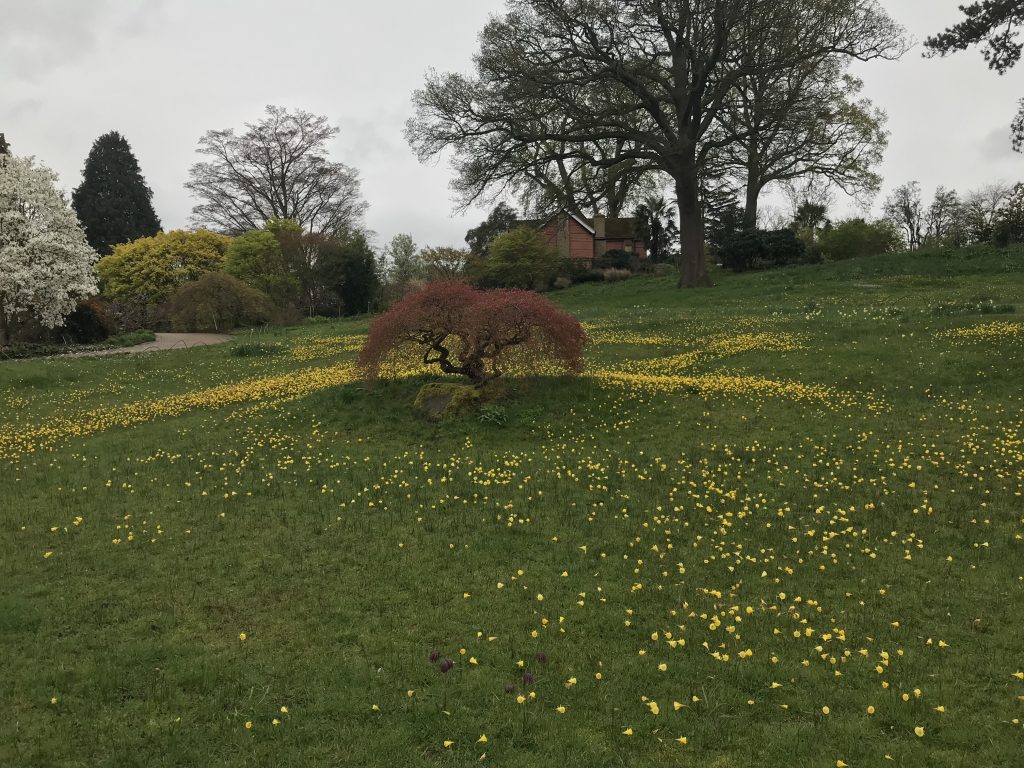
Nothing seems to take homeowners more time, or generate more frustration, than maintaining their lawns. In addition to mowing, fertilizing, and applying pesticides for weeds, insects, and diseases, gardeners fret about removing thatch and aerating the soil. Commercial interests have taken note and pedal various “aerifying” products like soap (cunningly described in non-soap terminology), spiked sandals, and thatching rakes. Previous posts (here and here) have addressed ways to decrease fertilizer and pesticide use. This post will look at the science behind aeration of home lawns.
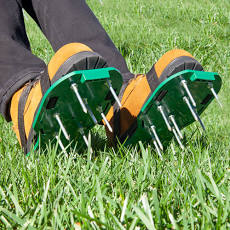
Iron maiden torture devices in sandal form 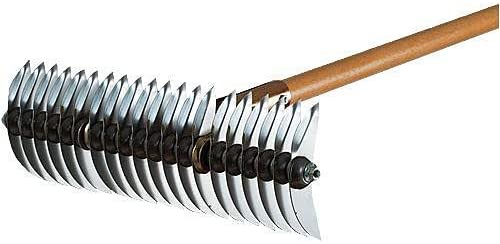
More lawn torture via thatching rakes 
That first ingredient in this aerifying product? It’s soap.
First, let’s acknowledge that most research has focused on maintaining turf on golf courses and playing fields. Neither of these are good models for home lawn management because home lawns have different functions. The turf that one might find on a putting green, for instance, is devoid of most life except for closely mown monocultural (or oligocultural) grasses. The management of these grasses is chemically and physically intensive to preserve a completely unnatural system. Yet these management techniques, including core aeration and vertical mowing (aka verticutting), have seeped into the lucrative home lawn maintenance market, especially to address the dreaded thatch layer common in many home lawns.
What is thatch?
Briefly, thatch is caused by organic material accumulating at the base of grass plants. (It is NOT caused by lawn clippings, which are small and nitrogen rich – they are broken down quickly.) Accumulation of thatch is said to lessen lawn resilience and increase disease, but this appears to be a classic CCC (correlation conflated to causation) error. I’ve seen nothing in the literature to suggest that thatch causes these problems. Instead, I see evidence that thatch is yet one more negative result of poor lawn management. Removing thatch, without addressing the CAUSE of thatch, is an exercise in futility.
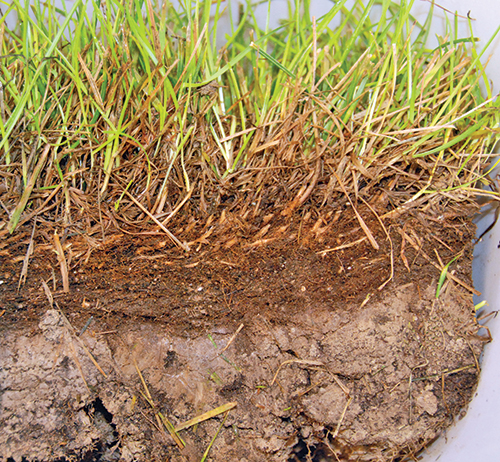
Lawn with thatch layer 
Natural grassland
Look at these two images of grass-covered soil: one is a typical lawn, and the other is a natural grassland. There are no roots extending below the “thatch” layer in the lawn, while grassland soils support deep and extensive root systems. The problem with the lawn is that the system is not well aerated, meaning that the grass roots are shallow and contribute to the buildup of thatch. Lack of aeration also inhibits a robust community of microbes, which are necessary to decompose the organic material that makes up thatch.
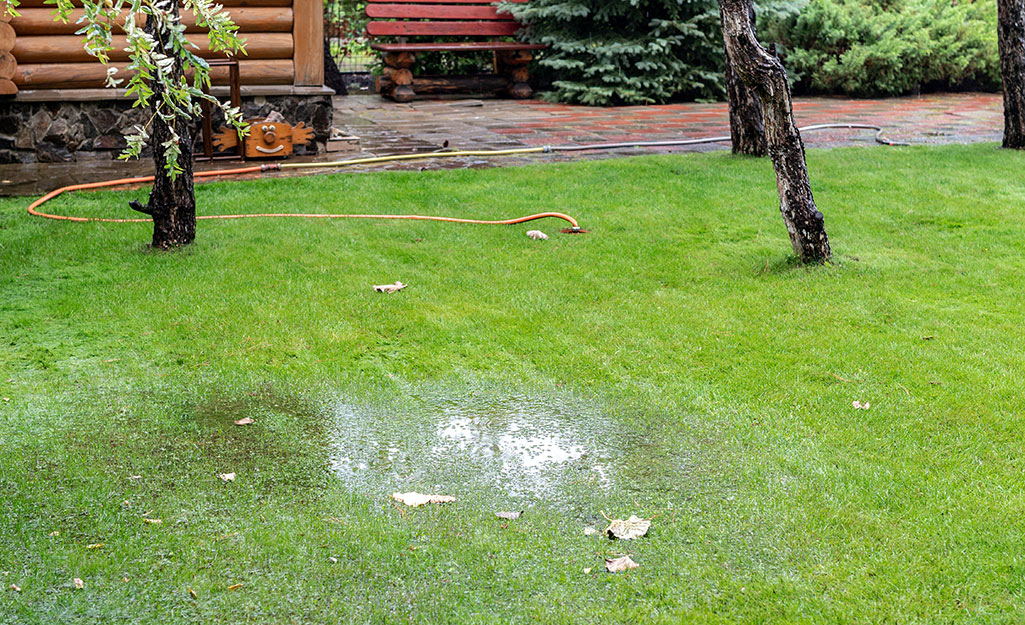
So, lack of poor oxygen and water movement between the grass layer and the underlying soil creates a dead zone in that soil, with life restricted to those few inches of soil where oxygen and water can penetrate. Thatch accumulates and underlying roots from nearby trees and shrubs are forced upwards into the lawn to obtain water and oxygen. This is where lawn maintenance companies promise to fix the problem through core aeration or verticutting.
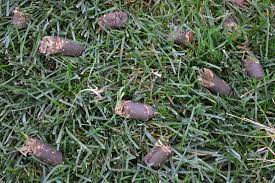
It’s not goose poop. It’s core aeration. 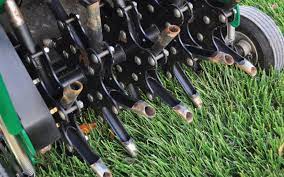
Vertical mowers look impressive but do they work?
Does core aeration and verticutting improve home lawns?
While there is scant research on home lawns, the results are fairly uniform: core aeration does not reduce thatch accumulation and does not improve grass coverage. Verticutting can decrease thatch slightly but decreases grass coverage and reduces turf quality. Several quotes from published research stand out:
- “All cultivation practices [which included core aeration and verticutting] resulted in some quality loss at various times during the spring transition period compared to the control.”
- “Thus, under homelawn conditions, core aeration and vertical mowing should only be used if a specific problem exists and not as routine practices to prevent thatch accumulation.”
- “After two years, no treatments consistently reduced thatch accumulation compared to the non-cultivated control.”
There is no published research, anywhere, that supports these techniques in maintaining healthy home lawns. So, it’s time to stop using these heavily promoted products and practices and instead focus on why lawns accumulate thatch in the first place.
It’s all about the oxygen!
There’s no question that lawns can be heavily compacted, but it’s not because grasses can’t tolerate foot traffic. Think about those hundreds of thousands of bison that use to roam the Great Plains grasslands. Even modern cattle ranching, done sustainably, does not damage pastureland by compacting the soil. There’s something else going on in home lawns that creates compacted conditions and the cascade of negative effects that follow; it’s improper soil preparation and management.

When sod is laid for home lawns, several inches of compost are tilled into the soil bed. The tilled soil is then flattened with a roller, and then a layer of sand is applied. Then the sod (which consists of grass and growing media and a mat of some sort) is arranged. And voilà! You have a turfed landscape that more closely resembles a five-layer dessert than a functional grassland. Those layered materials restrict the movement of water and oxygen, and this restricts root growth into the underlying native soil. Not only do these barriers create a shallowly-rooted turf, they compound the problem by stimulating ethylene gas production in grass, further inhibiting root growth. To top it off, the anaerobic conditions in the lower layers restrict microbial decomposition. As decomposition and root growth slow, thatch accumulates. And homeowners despair.
So, thatch serves as a warning sign that soil conditions are poor – and any attempts to permanently remove thatch without addressing poor soil preparation and management are going to fail. Possible corrective actions to improve soil structure and function are beyond the scope of this column; over the years we’ve had blog posts touching on this topic and I encourage readers to explore our blog archives.

Sod layers 
Jello layers



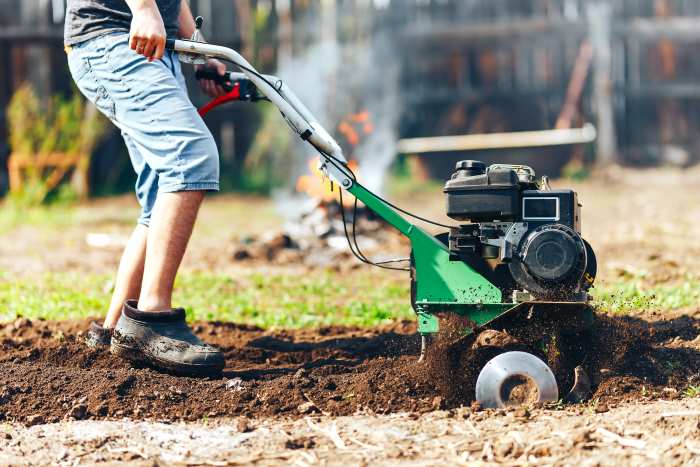


Perhaps it is a regional thing but I don’t know of any contractor in my area of southwest Ohio that uses sand when laying sod.
Sand is only one of the bad practices. It’s not going to make a difference.
This is excellent. However, it does not address the issue of fertilizer effect. I visited turf trials at Michigan State University and was impressed with the demonstration of how nitrogen source affected both root growth and thatch formation. Use of soluble high-N fertilizers caused quick and dense top growth and accumulation of thatch. Using low-N, slow-release fertilizers (especially those of organic origin, like Ringer’s Lawn Restore) promoted deep root growth and no thatch was observed. Here in Michigan we seldom use sod except in new building sites – seeded lawns work quite well. Thus no “Jello effect”.
And yes, core aeration does wonders, especially on the heavy clay soils we have around here.
Thanks! But as I said at the beginning, I was only focussing on aeration practices. We try to keep our posts to a reasonable length. And actually, research on nitrogen application was found to have no effect on thatch. So while there may be anecodotal evidence on the effect of fertlizer and core aeration, it needs to be put into a peer-reviewed publication before it’s considered to be reliable information.
Informative article. Perhaps this previous article should be amended/removed as it contradicts this one? https://gardenprofessors.com/do-your-homework-before-hiring-landscape-help/
Thanks! We leave all our posts up, because science continues to change. If nothing else, it shows that science isn’t dogmatic.
Your focus seems to be more on thatch control than anything else. You quoted a couple of research papers on aeration effects on thatch. But compacted soil also encourages weeds. If a homeowner wants a weed-free lawn, properly done core aeration will encourage turf grass to conquer the weeds without using herbicides.
My focus is on structural integrity and functionality of soils. Thatch is an issue that indicates a problem with soil conditions. You need published, peer-reviewed evidence relevant to home lawns to support your comment. I’ve looked, and I can’t find any.
You are right. I looked, couldn’t find anything but hoped you knew of something.
So with no research, one has to rely on simple observation of driveways lined with a foot-wide strip of oxalis, spurge and purslane. The soil gets compacted by car tires running off the pavement. Easy to fix by loosening the soil for turfgrass to grow.
Well, this is not exactly a home lawn. It’s more of a hell strip and any soil that’s driven over perpetually will be compacted regardless of its original structure.
Thanks for the info! I’ve been putting off aerating my lawn, but now I think I’ll skip it instead. We haven’t noticed significant issues with our lawn anyway, so I’ll focus my lawn-related efforts on better watering and mowing practices.
Hi,
thank you for this article. I find that one phrase in the end very important for me:
“So, thatch serves as a warning sign that soil conditions are poor – and any attempts to permanently remove thatch without addressing poor soil preparation and management are going to fail.”
Following your advice I went through blog’s archive to find a solution to a compacted soil, without a real effect. Rototilling is a no. Chemical/fluid solution are just a scam. What else can I do to fix it? How about addition of manure or compost (a thin layer every year) and patience?
Or maybe a biological solution, eg a specific plant seeded all over for one year, cut down at ground level and then to start a lawn (or even flower meadow) from scratch? Plants from Leguminosae are said to have deep roots, and I conclude that this would have a positive effect on every soil. It was grown in crop rotation for hundreds of years here in europe, and the sole purpose was to improve soil’s fertility.
Is there a chance that you could write about POSSIBLE ways to improve compacted soil?
The best way to improve compacted soil is to topdress with a thick layer of arborist wood chips. Nothing else will bring the physical, chemical, and biological improvements. We’ve discussed the benefits of arborist wood chips many times in this blog.
There are no plants that have special properties regarding deep roots. Roots grow where there is oxygen, nutrients and water. Over time cracks will form in compacted soils, allowing plant roots to follow those channels.
To be honest, the only way I could see to improve a lawn that’s built on a mess of different soils is to start over. But that’s an entirely different column.
“There are no plants that have special properties regarding deep roots.”
Does this mean it’s a myth that we can use plants with deep, thick roots like tillage radishes and turnips to “bio-drill” in order to to loosen up compacted soil? As described by articles like this one in the American Society of Agronomy’s “Crops and Soils”: https://www.nrcs.usda.gov/Internet/FSE_DOCUMENTS/nrcs142p2_022940.pdf
That’s correct. It’s a myth. The article you attached is not a research publication – it’s an anonymous opinion piece that consists primarily of anecdotal observations.
I have a front yard of compacted soil that was previously home to a thatched lawn very much like the cross-section picture above. The lawn was removed and I would like to plant a new healthy lawn (grown from seed, not sod), as shown in the grassland cross-section photo. Given the poor soil conditions, would I need to cover the area with wood chips for a period of time (1 year or more) before being able to achieve anything close to the grassland results?
It really wouldn’t take that long. If your lawn is already gone, scalp whatever is currentlu growing there, add a thick layer of wood chips (12″), then leave that in place until the fall. You then rake back the chips and sow a cool season grass seed (you might look at ecolawn choices). Mulch with a light covering of straw (not hay). You could overseed in the spring with a warm season mix if you wanted.
I would resist temptation to pull every weed out unless they are really bad weeds. Weed roots are going to help improve your soil right along with the grass roots.
Very sadly I am the new owner of a newly built turf layered lawn just as described here, ironically right on top of what used to be pastureland a couple of years ago. The natural soil seems to be heavy clay, layered over with a thick layer of sand, and on top is bermudagrass sod. Is there any hope of restoring it to a natural, healthy, lawn without a massive overhaul?
Have you done a soil test to see what you’re working with?
The sand on top of clay may create drainage issues so keep an eye on that.
Bermuda grass is very resilient and tough. Give it time and the best growing conditions you can and it’ll probably respond.